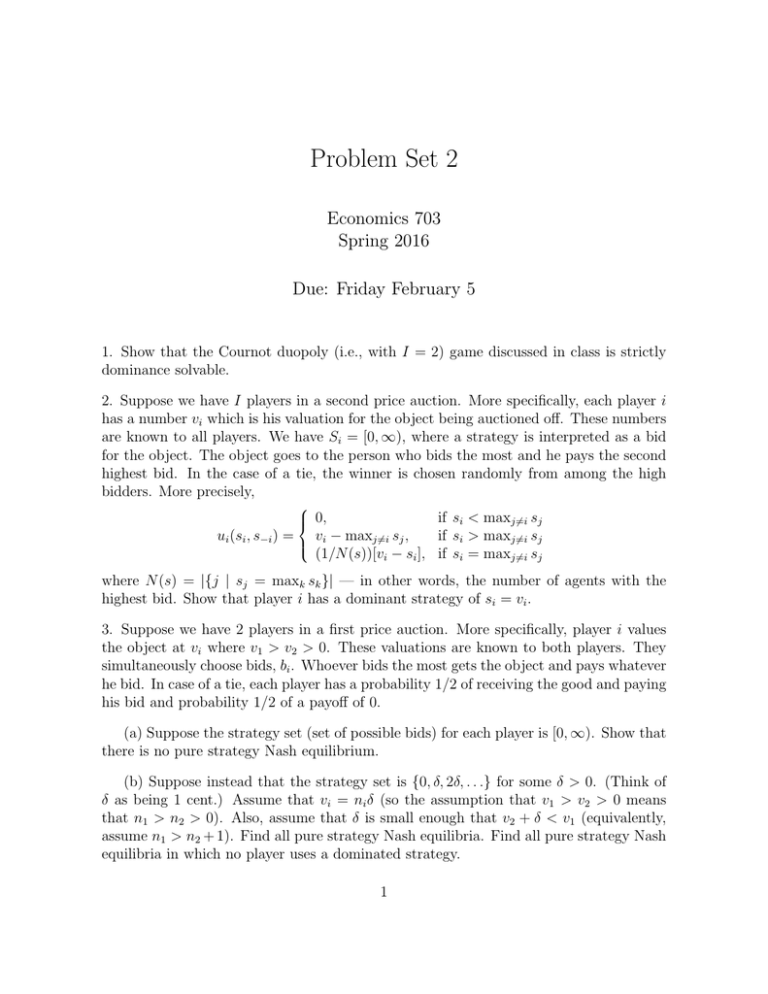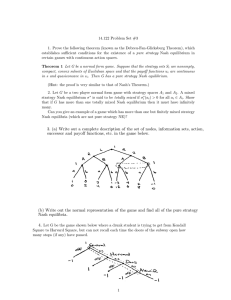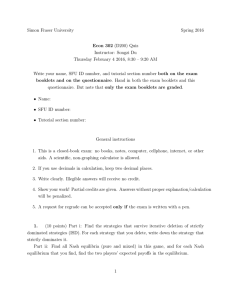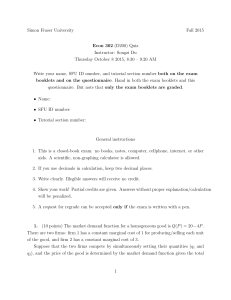Economics Problem Set: Game Theory & Auctions
advertisement

Problem Set 2
Economics 703
Spring 2016
Due: Friday February 5
1. Show that the Cournot duopoly (i.e., with I = 2) game discussed in class is strictly
dominance solvable.
2. Suppose we have I players in a second price auction. More specifically, each player i
has a number vi which is his valuation for the object being auctioned off. These numbers
are known to all players. We have Si = [0, ∞), where a strategy is interpreted as a bid
for the object. The object goes to the person who bids the most and he pays the second
highest bid. In the case of a tie, the winner is chosen randomly from among the high
bidders. More precisely,
0,
if si < maxj6=i sj
if si > maxj6=i sj
ui (si , s−i ) = vi − maxj6=i sj ,
(1/N (s))[vi − si ], if si = maxj6=i sj
where N (s) = |{j | sj = maxk sk }| — in other words, the number of agents with the
highest bid. Show that player i has a dominant strategy of si = vi .
3. Suppose we have 2 players in a first price auction. More specifically, player i values
the object at vi where v1 > v2 > 0. These valuations are known to both players. They
simultaneously choose bids, bi . Whoever bids the most gets the object and pays whatever
he bid. In case of a tie, each player has a probability 1/2 of receiving the good and paying
his bid and probability 1/2 of a payoff of 0.
(a) Suppose the strategy set (set of possible bids) for each player is [0, ∞). Show that
there is no pure strategy Nash equilibrium.
(b) Suppose instead that the strategy set is {0, δ, 2δ, . . .} for some δ > 0. (Think of
δ as being 1 cent.) Assume that vi = ni δ (so the assumption that v1 > v2 > 0 means
that n1 > n2 > 0). Also, assume that δ is small enough that v2 + δ < v1 (equivalently,
assume n1 > n2 + 1). Find all pure strategy Nash equilibria. Find all pure strategy Nash
equilibria in which no player uses a dominated strategy.
1
4. Suppose we have an economy with N people. There is a public good which is only
provided if at least one person gives up c ∈ (0, 1) dollars to pay for it. Consider the
following game. Each person simultaneously decides whether or not to contribute c. If
at least one person contributes c, each contributor gets 1 − c and each noncontributor
gets 1. If no one contributes, everyone gets a payoff of zero.
(a) What are the pure strategy equilibria of this game?
(b) Find the unique symmetric mixed strategy equilibrium of this game. (By “symmetric,” I mean an equilibrium in which everyone uses the same mixed strategy.) What
is the probability that at least one person contributes in this equilibrium? Show that
as N → ∞, the probability that someone contributes converges to something strictly
between zero and one. (That is, we have uncertainty about the outcome even in the
limit.)
2











